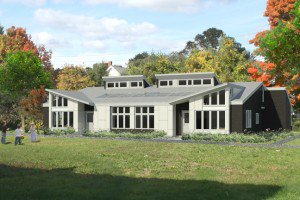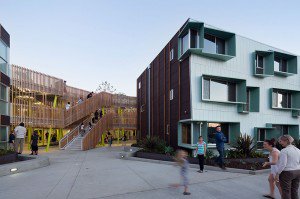Share This
Related Posts
Tags
Green Affordable Housing
By Erica Rascón on Jul 22, 2014 in News
The widespread presence of sustainability features in affordable housing is finally underway thanks to changes in government regulations and financing incentives. Key green features are in high demand, forming a new standard in affordable housing.
Affordable housing communities are becoming greener from the ground up, beginning with optimal placement: the north-south and east-west orientation of structures can help builders capitalize on passive solar energy or greater access to natural light, both of which can help tenants cut utility costs.

Stoneham Barrier Free Housing
Such passive solar housing units were recently added to Stoneham Barrier Free development in Massachusetts. By situating the buildings towards the sun, the units receive passive solar heating. During the summer, overhangs provide shading to keep units cooler. Clerestory windows channel natural light throughout the residences resulting in lower power bills for tenants.
Developers are also taking advantage of smarter envelopes to create more efficient interiors. Since air leakage accounts for 25-40 percent of energy usage, constructing an airtight envelope promotes maximum indoor climate control and reduces energy waste. A tight envelope also helps to control moisture in living quarters and basements, minimizing the likelihood of mold, mildew, and moisture-related damages that carry significant costs for owners.
What energy is needed to power affordable housing communities is furnished, at least in part, by renewable energy sources. Solar panels are more affordable and diverse than ever, coming in a variety of space-friendly styles to accommodate multifamily applications. Other innovative technologies, such as the use of algae and living concrete, offer properties a way to generate their own power and potentially sell power back to energy providers.
“The Mennonite” is the nation’s first multi-family affordable passive house apartments, implementing an airtight envelope and on-site renewable energy sources. The $8.5 million structure will offer 24-units of green living for handicapped and low-income residents. With 16 thermal solar panels, triple-pane windows, and an energy-recovery ventilator system, the site has set a new precedent for affordable and sustainable living in the inner city.
The environmental and health benefits of cleaner indoor air have also caught the attention of developers. Several communities nation-wide have opted to transform their new and existing properties into smoke-free housing; Related Companies took the challenge a step further by converting of their entire portfolio, including affordable housing developments in 17 states. In addition to providing healthier air for tenants, smoke-free living benefits owners as well. Owners can cut costly insurance claims and minimize expenses associated with odor removal.
Fresher indoor air can be accomplished through the use of passive ventilation, achieved by orienting the shorter axis of a structure with prevailing winds. When other buildings or geographical features are in the way, builders can resort to internal structural elements that channel air throughout the building. Both methods improve indoor air circulation to promote healthier living conditions.

Broadway Housing
Kevin Daly Architects’ Broadway Housing in Santa Monica utilizes passive ventilation, vegetative screens, and windows facing a breezy central courtyard to create 33-units of comfortable, affordable housing that does not rely on air conditioning for fresh air. Interiors are decorated with CRI green-label carpet, low-VOC paints and formaldehyde-free insulation to help residents breathe easier.
Lastly, location has become more important than ever for affordable housing developers. Renters are seeking housing in pedestrian friendly corridors with easy access to public transit. In addition to consumer demand, governmental bodies are also encouraging public transit, issuing policies to promote the placement of affordable housing near transit lines. Sustainable affordable housing and mass transit were irrevocably linked in California Senate Leader Darrell Steinberg proposal to allot 35 percent of Cap-and-Trade funds to affordable housing construction. Austin City Council is currently voting to require any new affordable housing proposals to have locations within a half-mile of public transit options. Decreasing carbon emissions and creating parks instead of parking lots can go a long way to improve health and sustainability in urban areas.
As more developers take advantage of the financing incentives linked to sustainability, we can look forward to more green affordable housing properties. These communities will be valuable assets to their neighborhoods and tenants. Finally, more low-income households will reap the cost-saving benefits of sustainable living.
